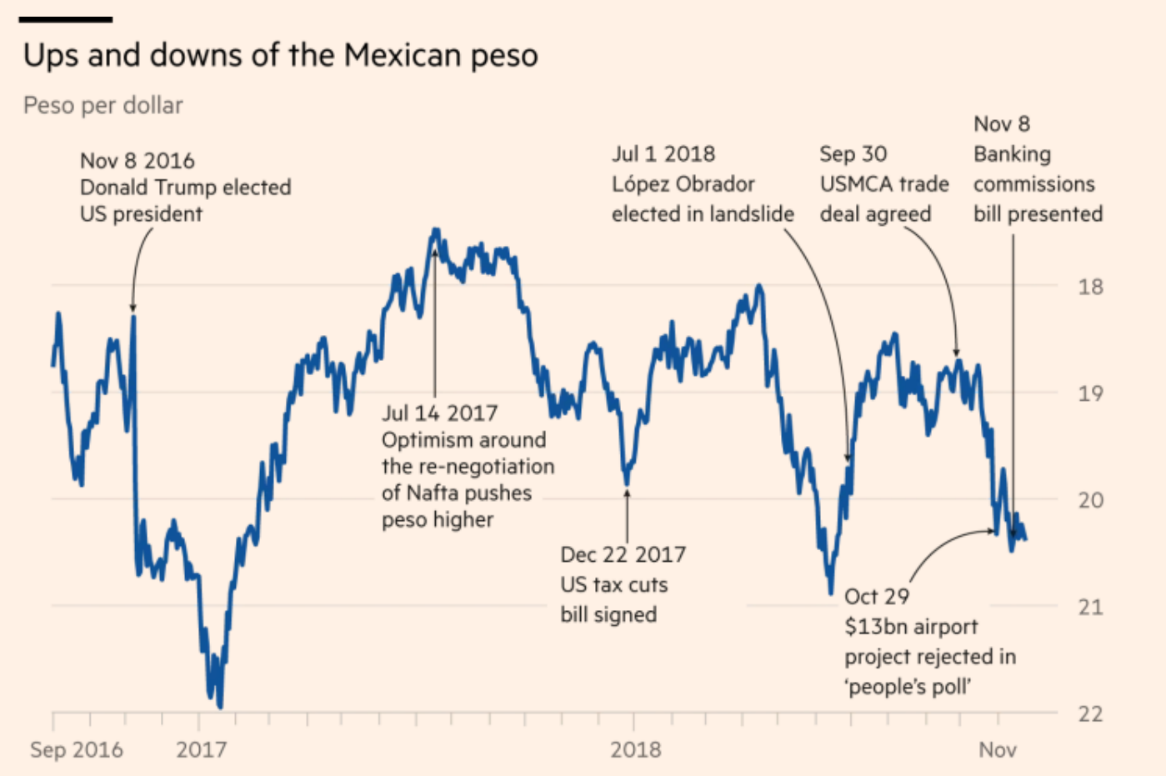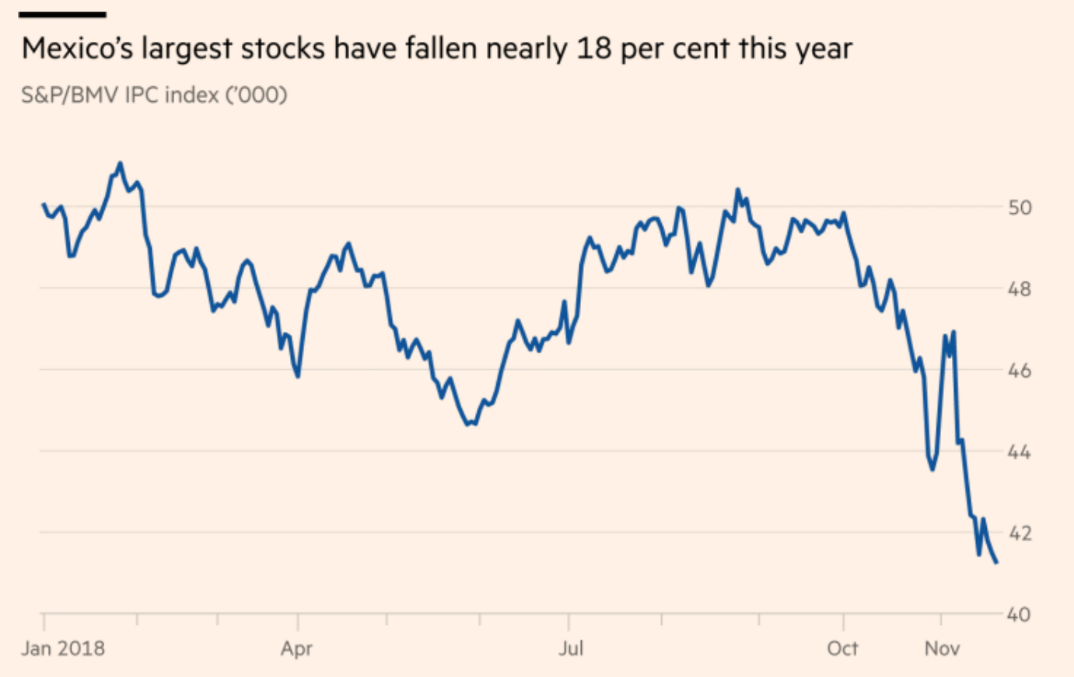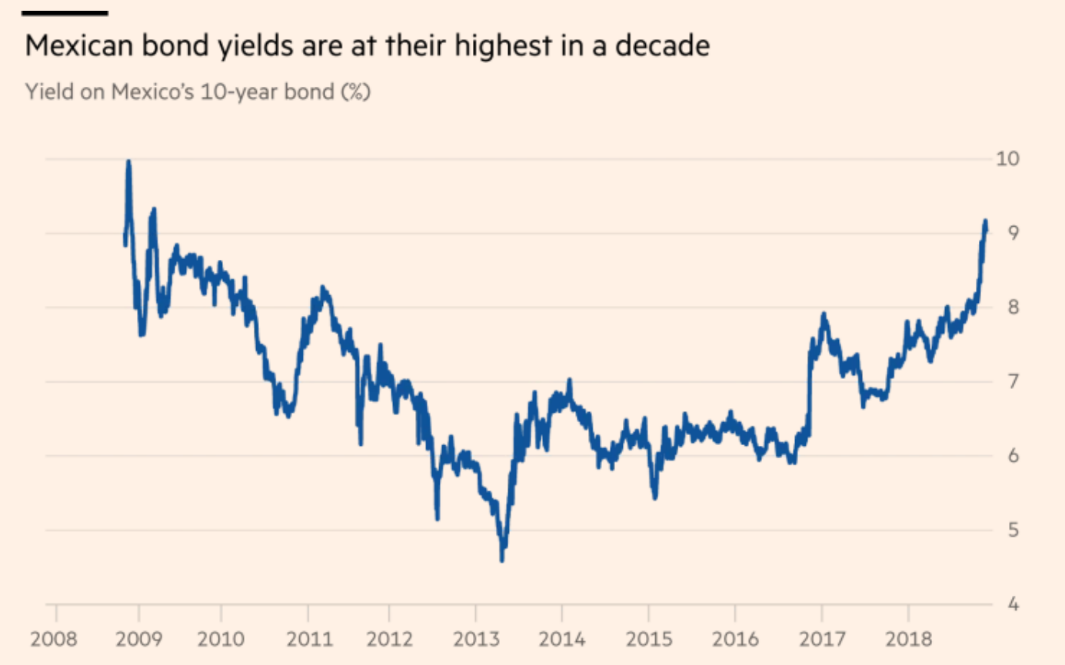Financial Times
Publicado en Financial Times.
Are the president-elect’s promises to stage referendums on everything from infrastructure to the police a cover to consolidate power?
Jude Webber in Mexico City NOVEMBER 24, 2018
Mexico’s president-elect Andrés Manuel López Obrador likes to surround himself with photographs or busts of his historical heroes. But in a video posted on social media on October 30 he had a new prop. Prominent on a table beside him as he smiled into the camera was a book called Who’s In Charge Here?
The leftist nationalist clearly wanted to send the message that he answered only to the Mexican people, not to the financial markets or investors who had been staggered by his decision, announced a day earlier, to scrap a partially-built $13bn airport project. The move came after the incoming government organised an informal “people’s poll”, which critics say lacked legitimacy and was biased against the project. But the carefully constructed scene’s unequivocal subtext was: “I am.”
It was a first taste of the participatory democracy Mr López Obrador had promised. He had long opposed the costly airport project, which had been under fire from environmentalists. Investors, who had quietly been assured by some in the incoming government that the project was safe, were aghast, despite its promises to repay financial obligations in full.

“There’s been a change in the country. We have to let some people know that there is another Mexico now,” said Mr López Obrador in the video. “I’m not going to be decorative.”
Indeed, the 65-year-old history buff takes power this Saturday as a latter-day Aztec emperor, with the opportunity to centralise vast power under his command after a landslide victory — he won 53 per cent of the vote — on July 1. The result gave him the strongest presidential mandate in a generation. He controls both houses of congress and can immediately put his stamp on the Bank of Mexico, where two seats have come up on the five-member board, and on the Supreme Court, where two vacancies will become free by February.
Financial markets could be his inaugural sacrifice, with the currency, stocks and bond yields all yet to recover to the levels they were at before the airport poll. The peso is now at its weakest in five months; the stock market has retreated; and Mexico’s 10-year bond yields are at their highest in a decade. Mr López Obrador has simply shrugged off market consternation as “normal” and told investors that people’s polls are here to stay.
“Imagine the Mexican state . . . subjugated to the financial markets,” he told reporters on October 29, with a look of incredulity on his face, as he confirmed he would axe the Norman Foster-designed airport, which is one-third built, after a poll in which just 1 per cent of Mexico’s 130m people took part.
“Who’s in charge? Isn’t it the people? Isn’t it citizens? Isn’t it democracy?” he asked. “This is what we’re changing.”
Unimpeded political power in a country with weak institutions and huge popularity appear to have convinced the veteran politician that the markets, seen by many as a potential check on his power, should also be subservient to his will.
Yet the honeymoon period has come screeching to a halt even before the new presidency has begun.

Mexico’s business elite and international investors had initially swallowed their fears that Mr López Obrador represented a one-way ticket back to the state-centric 1970s or a slippery slope towards Venezuela-style ruin — a prospect routinely whipped up by his opponents — in Latin America’s second-biggest economy.
Despite Mr López Obrador’s Trump-like insistence on putting nationalist concerns first, they took comfort in his promises of fiscal prudence, hoping that he would quietly kill off some of his more populist-sounding proposals — like construction of a costly oil refinery to boost domestic production or a vow to halt lucrative oil exports.
They were reassured by the appointment of Alfonso Romo, the cabinet chief who hails from the business sector, and the presence of technocrats such as Carlos Urzúa at the finance ministry.
Like many Mexicans disgusted by rampant corruption, investors applauded the president-elect’s promises to eradicate graft and pacify a country where the murder rate climbed to record highs under outgoing president Enrique Peña Nieto, Mexico’s least loved leader in recent history.
A new Nafta deal — dubbed USMCA — had been agreed with the US and Canada, removing uncertainty that had paralysed investment decisions for two years. With an expanding economy and recovering oil prices, the new administration looked set fair.
Instead, the incoming administration has painted itself into a corner by promising not to increase debt in real terms and to cut taxes along the US border which, he says, will boost jobs and growth. “Where is he going to get the money for projects?” asks one former senior government official. “In the worst-case scenario, he might force the hand of the pension funds [to invest in state projects], that’s the danger. That would be a disaster for markets.” The president-elect says he will fund projects by ending corruption and curbing non essential spending.
According to the Bank of Mexico, foreign investors shed $2.2bn of government bonds in October, and fund managers report more sell-offs since the airport decision.
At the same time international pressures are multiplying: USMCA faces a rough ride in the US Congress. And although oil now only makes up 17 per cent of Mexico’s budget revenues — down from 40 per cent in 2012 — falling oil prices will give the incoming administration less fiscal room for manoeuvre.
Market concern deepened when a senior senator in Mr López Obrador’s party presented a bill to scrap banking fees this month that sent shares in financial institutions crashing. Another senator introduced a bill to make mining concessions conditional on consent from indigenous landholders — a move that could slow down projects or make them more costly.
And before the dust had even settled on the first consultation, Mr López Obrador had announced two new people’s polls. The first, this weekend, asked whether Mexicans support the planned refinery, two train projects in the poorer south and a string of social programmes. Another is planned for March 21, when respondents will be asked if they approve the consolidation of current police forces into a new national guard, under military control.

 Mr López Obrador believes investors need to readjust to a new reality of representative democracy, in which citizens are consulted over key projects, crony capitalism is out and the poor come first, instead of policies that he has described as tantamount to “pillaging”. According to official data, 44 per cent of the population is classed as poor.
Mr López Obrador believes investors need to readjust to a new reality of representative democracy, in which citizens are consulted over key projects, crony capitalism is out and the poor come first, instead of policies that he has described as tantamount to “pillaging”. According to official data, 44 per cent of the population is classed as poor.
“It’s not that they [the incoming government] don’t understand markets — it’s not quantum physics,” says Valeria Moy, head of México ¿Cómo Vamos?, a think-tank. “I think they understand, but they don’t care.”
Mr López Obrador wants to teach markets a lesson — but he himself faces a make-or-break test. By December 15, his government must present the 2019 budget. It has promised to make cuts so as to be able to reallocate resources to two signature social programmes, offering bursaries and apprenticeships for young people, and increased pensions for the elderly.
But the risks are escalating: rating agency Fitch put Mexico on negative outlook after the airport decision and Moody’s sovereign risk analyst Jaime Reusche says the poll was a “negative sign for long-term investments in the country, which could discourage investment in the medium-term and slow down economic growth”.
The son of shopkeepers, Mr López Obrador maintains his government will not spend beyond its means. “But how credible the savings targets are, and how capable they are of generating them, remains to be seen,” says Luis Arcentales, co-head of Latin America economics at Morgan Stanley.
Mr López Obrador has promised a primary surplus of 0.8 per cent of gross domestic product for next year as well as no new debt and no increases in taxes or petrol prices.
It is a tall order, Mr Arcentales says. “If we use reasonable assumptions for the peso, oil prices and crude production, we cannot get to that [surplus] number, assuming they keep to the pledge to keep the borrowing requirements in 2019 the same as 2018 [2.5 per cent of GDP].”
He believes there could be a fiscal shortfall of as much as 0.8 per cent of GDP — something that could strain market sentiment further.
Mr López Obrador may not aim to please the markets, but nor is he on a suicide mission. He stepped in to quash expectations of approval for the banking commission bill, amid confusion over whether or not it had his support.
His appointment of independent economist Jonathan Heath to a seat on the central bank board was also well received. And he will win brownie points with investors if he demonstrates commitment to Banxico’s independence by appointing another respected figure to a vacancy created by the surprise resignation, on health grounds, of another board member.
But his appointment of an advisory council of senior business figures may have come too late to repair rattled investor confidence and he will have his work cut out to convince them that they can really trust him. “If the budget is not very solidly anchored, his credibility may not last long,” says one independent economist, considered close to the incoming president, but who admits to harbouring serious concerns.
Students of Mexican economic history recall the painful “December Mistake” in 1994, when markets lost faith in the new government of Ernesto Zedillo amid a liquidity crunch, precipitating the tequila currency crisis when the country nearly went bankrupt, was forced to devalue its currency and was ultimately bailed out by the US and IMF.
The economy today bears no resemblance to the situation then, but with risk perception, measured by credit default swaps, already rising sharply, there is no room for error.
The president’s office will be the imposing 16th century National Palace in Mexico City’s main square. It is built on the site of the palace of Moctezuma, the emperor in power when the Spanish conquerors arrived.
“With so much legitimate power at his disposal, why resort to [polls] and say the people have spoken? He can bypass the nation’s institutions and impose what he wants,” says Walter Molano of BCP Securities, who is advising clients to reduce exposure to Mexico or get out altogether.
Will Mr López Obrador heed his market critics? “He might realise that his path is not sustainable, leading him to moderate his course or at least stagger his spending plans,” says Till Moewes, Latin America credit analyst at Schroders, which is heavily invested in Mexico. “Admittedly, this is still a long shot, but it would not be the first time in history that a leftist politician becomes more centrist over time — not because he wants to, but because he has to.”
But “some people are hoping he gets tested quickly so he gets a bloody nose and becomes more disciplined”, says the former senior official.
Mr López Obrador says the people hold his fate in their hands: he is planning a recall referendum in 2021, halfway through his term. But it could be a rocky three years.
“[When he was elected] I was optimistic,” the chief executive of one of Mexico’s biggest companies told the FT. “Now I’m just hopeful.”
